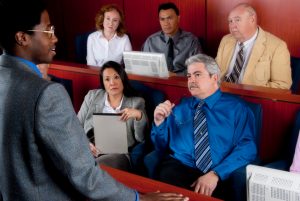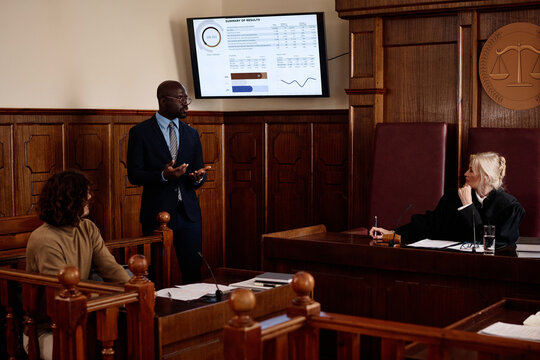Why Your Next Situation Demands a Solid Trial Presentation: Insights and Techniques for Lawyers
Wiki Article
Navigating the Intricacies of Trial Presentations: Tips for Seamless Distribution and Compelling Disagreements
In the world of legal procedures, the art of test presentation stands as an essential component of success. As lawyers browse the complex web of court room characteristics, the capacity to flawlessly provide disagreements and evidence while mesmerizing the jury's interest becomes paramount. The complexities intrinsic in test presentations require a fragile balance of technique, finesse, and ability. By honing methods that ensure a refined delivery and crafting engaging arguments that resonate with the audience, lawful experts can dramatically improve their advocacy. In a globe where persuasion reigns supreme, grasping the details of trial presentations is not just a choice yet a requirement for those looking for to dominate in the court.
Recognizing Trial Purposes
To properly navigate a test, it is essential to have a clear understanding of the goals that require to be attained. Prior to entering the court room, legal groups need to define their objectives and preferred end results. These objectives function as guiding principles throughout the trial, shaping strategies and influencing decision-making processes.Comprehending test objectives involves a comprehensive evaluation of the situation, lawful precedents, and the client's finest rate of interests. Trial Presentations. It calls for a precise assessment of the truths, determining key issues, and preparing for potential difficulties. By establishing quantifiable and certain objectives, attorneys can tailor their discussions and disagreements to line up with the wanted outcomes
Furthermore, a clear grip of test goals makes it possible for lawful teams to focus on proof, witnesses, and legal disagreements successfully. It enables for the advancement of a systematic narrative that resonates with the discretionary, enhancing the overall instance discussion.

Organizing Proof Successfully
Having a clear understanding of test goals lays the structure for organizing evidence efficiently in legal procedures. By aligning the presentation of proof with the preferred end results of the trial, lawful groups can enhance their arguments and enhance their persuasiveness.One more key aspect in organizing evidence effectively is developing a logical flow. Providing evidence in a coherent and sequential way can aid build a compelling narrative that sustains the lawful disagreements being made. Additionally, making use of visual help such as graphs, timelines, or graphes can better improve the organization of proof and help in clearing up complicated relationships or sequences of events.
Additionally, making certain that all evidence presented is acceptable and appropriate to the instance is important. Inadmissible or unimportant proof can diminish the stamina of the argument and potentially harm the integrity of the here and now event. A meticulous review and selection process must be embarked on to include just the most legally audio and impactful evidence in the test presentation.
Crafting Convincing Stories
Crafting engaging stories plays an essential function in providing influential debates throughout lawful process. When constructing a story for a test presentation, it is important to develop a clear story that highlights key points and attaches them in a meaningful fashion. By weaving together proof, testament, and legal disagreements right into a visit their website cohesive and persuasive narrative, lawful specialists can properly advocate for their customers and increase the likelihood of a favorable result in the court.
Grasping Aesthetic Aids
Efficient use visual aids is essential to enhancing the impact you can try this out and clarity of trial discussions. Aesthetic aids, when utilized purposefully, have the power to simplify complex info, enhance essential factors, and leave a lasting perception on the judge and jury. To understand aesthetic help in trial discussions, it is essential to ensure that they are clear, succinct, and appropriate to the debates being made.When including aesthetic aids, such as graphes, timelines, pictures, or charts, right into a test presentation, it is crucial to keep them visually appealing yet expert. The visuals ought to complement the verbal arguments, giving a graph of the info being talked about without frustrating the target market with unneeded information.
Furthermore, experimenting the visual aids beforehand is critical to make certain a smooth delivery throughout the test. Familiarizing oneself with the material, transitions, and timings of each aesthetic help can help preserve the flow of the discussion and stop technological problems that may occur.
Providing Impactful Closing Arguments
An engaging closing debate works as the end result of a test presentation, encapsulating the core narrative and encouraging the court and court towards a beneficial decision. To supply an impactful closing argument, it is critical to succinctly summarize vital factors, highlight the strengths of your case, and resolve any type of weaknesses in a tactical fashion. Begin by describing the main disagreements that sustain your client's setting, stressing why the proof provided throughout the test sustains your story. It is necessary to produce a feeling of communication and quality, directing the discretionary in the direction of the desired final thought.Moreover, integrating sob story can even more strengthen your closing argument. By humanizing the situation and attaching on a personal degree with the decision-makers, you can stimulate empathy and understanding, affecting their perception of the realities offered. In addition, stating the lawful criteria that need to be fulfilled for a positive judgment can strengthen the credibility of your position. Inevitably, a well-crafted closing debate must leave a long lasting impact, compelling the judge and visit site jury to regulation in your customer's support.
Verdict
To conclude, understanding trial discussions involves comprehending objectives, organizing evidence, crafting stories, making use of visual aids, and supplying impactful closing debates. By executing these techniques successfully, legal representatives can offer their situation seamlessly and make compelling debates in the court. It is vital to navigate the complexities of trial discussions with precision and ability to accomplish success in legal process.By lining up the presentation of evidence with the wanted end results of the trial, legal groups can reinforce their arguments and improve their persuasiveness (Trial Presentations). To understand visual aids in test presentations, it is vital to make certain that they are clear, concise, and relevant to the disagreements being made
An engaging closing argument offers as the end result of a trial presentation, enveloping the core narrative and encouraging the judge and jury towards a favorable decision. Begin by describing the primary debates that sustain your customer's setting, highlighting why the evidence offered throughout the trial sustains your narrative.In verdict, grasping trial presentations involves understanding goals, arranging proof, crafting stories, utilizing visual aids, and supplying impactful closing arguments.
Report this wiki page